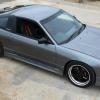tyre pressure for the track
Announcements
-
Similar Content
-
Latest Posts
-
I ❤️ Matty I would like to thank Matty for going out his way in securing me a OEM NC detachable hard top for the NC Matty, your worth your weight in gold, and I cannot say how much I really appreciate your outstanding help I'll get it colour matched once I pick it up sometime in Dec-Jan 😁
-
We have some genuine Japanese legally decommissioned car number plates now in stock 🙂 Add some legitimately obtained JDM style to your Skyline or other Japanese model, or simply as a garage/man cave decoration! About the 40mm hole: The Ministry of Land, Infrastructure & Transport in Japan recognised the popularity of keeping decommissioned plates among car enthusiasts and came up with a method to "destroy" (or render them unusable for street use) while still retaining their collectable/usable value for display etc. We have 40mm hole covers available to cover the hole nicely with a Sakura motif, which are also available in white in (very!) limited quantities, however they frequently sell out. Please let me know if you're wanting one or more of these and I'll check availability. The Sakura motif covers are more common. https://www.oemsoko.co.jp/products/genuine-decommissioned-japanese-vehicle-number-plate-set-su-7515 https://www.oemsoko.co.jp/products/genuine-decommissioned-japanese-vehicle-number-plate-set https://www.oemsoko.co.jp/products/genuine-japanese-vehicle-number-plate-400mm-hole-cover *Please note that we can't obtain particular number or area name (eg: "Gunma 500 Fu ・86") if requested. All plates are provided as they become available after decommissioning.
-
By MidnightR32 · Posted
Ah, fair enough. For the IAT, I'm using a legit GM sensor that was used on the car prior to my current build. I'll get another wideband and IAT ordered and follow up when they show up. Thanks for the help. -
You shouldn't need to massively fatten up the mixtures for cold conditions. For one thing - 0°C is not that cold. For another, the Haltech will be using the IAT sensor to tell it how dense the air air, and calculate the correct amount of fuelling. Then the cold start enrichment is added as a % on top of that, so it should scale with the main fuelling. You might also doubt the IAT sensor at this time. You're not using one from an RB26 are you? Using a nice Bosch sensor or similar? Happens. Some wideband units take great pleasure in killing their sensors. Put another wideband in the tailpipe and compare. Or just swap the sensor to a brand new one and see.
-
By MidnightR32 · Posted
Oh, my misunderstand. When the car was running, it sounded ok, but if I gave it any gas it wanted to die but caught itself afterwards. It's very different from how it was a couple months ago when it was warmer outside. The logs show that the AFRs are better during, what I assume, is warmup enrichment. Because it's cold, and air is more dense, should I work on the enrichment bit?
-







Recommended Posts
Create an account or sign in to comment
You need to be a member in order to leave a comment
Create an account
Sign up for a new account in our community. It's easy!
Register a new accountSign in
Already have an account? Sign in here.
Sign In Now